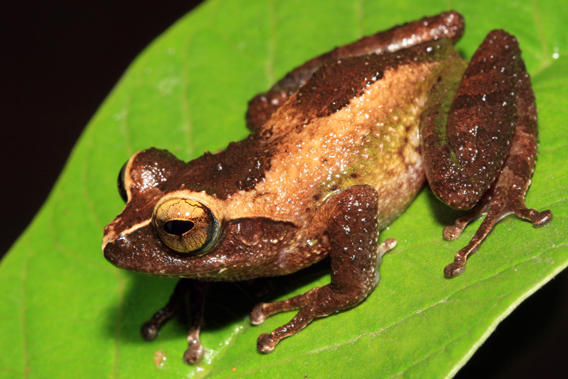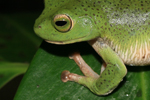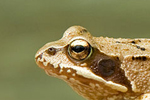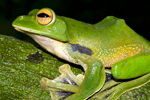
A new species discovered in the Peak Wilderness Sanctuary: Pseudophilautus sirilwijesundarai. Photo by: L.J. Mendis Wickramasinghe.
Two surveys in the mountainous forests of Sri Lanka’s Peak Wilderness Sanctuary have uncovered eight new species of frogs, according to a massive new paper in the Journal of Threatened Taxa. While every year over a hundred new amphibians are discovered, eight new discoveries in a single park is especially notable. Sri Lanka is an amphibian-lovers paradise with well over 100 described species, most of which are endemic, i.e. found only on the small island country. Unfortunately the country has also seen more frog extinctions than anywhere else, and seven of the eight new species are already thought to be Critically Endangered.
Although the discoveries are hugely important for the Peak Wilderness Sanctuayr, lead author of the paper L.J. Mendis Wickramasinghe with the Herpetological Foundation of Sri Lanka told mongabay.com that he wasn’t surprised to uncover eight new frogs there.
“The survey in this area was initiated due to the lack of research work carried out in this area, and looking at its geography, and altitudinal changes which varies from about 600 meters-2200 meter, and the vegetation varying from lowland rain forests to cloud forests, we knew that the area’s biodiversity was under represented,” he explains, adding that “tough terrain” and “harsh weather conditions” have kept scientists out until now. The Peak Wilderness sanctuary is home to Sripada peak, an important place for not just biodiversity, but a for a wide variety of world religions, including Christianity, Hinduism, Islam, and Buddhism.
Each of the new species are in the Pseudophilautus genus, which is only found in Sri Lanka and nearby India. In addition, each one is easily distinguishable from the other by their morphological features, bucking a recent trend where genetics are increasingly used to find new species that look alike.
The eight new species aren’t the only discovery from the Peak Wilderness Sanctuary, which has been dubbed a World Heritage Site. Another paper by Wickramasinghe and his team recently announced the re-discovery of the starry shrub frog (Pseudophilautus stellatus), which had not been seen for 160 years and was believed to be extinct. He says all these discoveries would not have been possible without the help of project funders, including The Biodiversity Secretariat of Sri Lanka, Nagao Natural Environmental Foundation in Japan, and the Dilmah Conservation Sri Lanka.
However most of the species, including the starry shrub frog, should be listed as Critically Endangered, according to the scientists. Habitat loss, small hydropower plants, and pollution from visiting pilgrims are some of the major threats to these long-hidden frogs.
“But apart from [this] the government is planning to construct a helipad in the area of concern right now!” Wickramasinghe lamented.
Amphibians are one of the most endangered family groups in the world. Experts say that are one third of the world’s amphibians are currently threatened due mostly to habitat loss, pollution, and a killer-disease known as chytrid fungus which has likely been spread by humans and exotic frogs. Scientists think that around 130 amphibians have gone extinct since 1980, about 20 of which were found in Sri Lanka.
Even these eight new frogs may not be the last we hear from herpetologists working in the Peak Wilderness Sanctuary.
“There are many more [new species] to be published this is just a fraction of what remains to be uncovered,” Wickramasinghe told mongabay.com tantalizingly. Stay tuned.

The dramatic Sripada peak where many of the new species were discovered. Photo by: L.J. Mendis Wickramasinghe.
New species: Pseudophilautus bambaradeniyai. Photo by: L.J. Mendis Wickramasinghe.

Pseudophilautus dayawansai. Photo by: L.J. Mendis Wickramasinghe.

Pseudophilautus jagathgunawardanai. Photo by: L.J. Mendis Wickramasinghe.

Pseudophilautus karunarathnai. Photo by: L.J. Mendis Wickramasinghe.

Pseudophilautus newtonjayawardanei. Photo by: L.J. Mendis Wickramasinghe.

Pseudophilautus puranappu. Photo by: L.J. Mendis Wickramasinghe.

Pseudophilautus samaracoon. Photo by: L.J. Mendis Wickramasinghe.
CITATION: L.J. Mendis Wickramasinghe, Dulan Ranga Vidanapathirana, M.D. Gehan Rajeev, S. Chathuranga Ariyarathne, A.W. Amila Chanaka, L.L. Dharshana Priyantha, Imesh Nuwan Bandara, Nethu Wickramasinghe. Eight new species of Pseudophilautus (Amphibia: Anura: Rhacophoridae) from Sripada World Heritage Site (Peak Wilderness), a local amphibian hotspot in Sri Lanka. Journal of Threatened Taxa. 13 March 2013. 5(4): 3789–3920.
Related articles
The beautiful amphibian from Hell: scientists discover new crocodile newt in Vietnam (photos)

(03/19/2013) Researchers have discovered a new species of Vietnamese salamander that looks like it was birthed from an abyssal volcano. Found tucked away in Tokyo’s National Museum of Nature and Science, the scientists described the species in the new edition of Current Herpetology. Coal-black with orange-tinted toes, the new crocodile newt (in the genus Tylototriton) was determined to be a new species when it showed morphological and genetic differences from near relatives. Despite its remarkable appearance, the researchers say these are typical colors for crocodile newts.
Scientists clone extinct frog that births young from its mouth
(03/18/2013) Australian scientists have produced cloned embryos of an extinct species of frog known for its strange reproductive behavior, reports the University of New South Wales.
Captive frogs may be spreading diseases to wild cousins across Southeast Asia
(03/07/2013) Scientists have documented a series of links between exotic frogs for trade and diseases in wild frogs in Southeast Asia, including the first documented case of the chytrid fungus—a virulent and lethal disease—in Singapore. According to researchers writing in a new study in EcoHealth, frogs imported into Southeast Asia as pets, food, or traditional medicine are very likely spreading diseases to wild populations.
Starry frog rediscovered after thought extinct for 160 years (photos)

(03/07/2013) In 1853 Edward Frederick Kelaart, a physician and naturalist, collected a strange frog on the island of Sri Lanka then a British colony known as Ceylon. The specimen was a large shrub frog (about 2 inches or 5.5 centimeters long) with black-outlined white specks on lime-green skin. He dubbed it “starry” after its pale specks, but that was last anyone heard of it. Even the holotype—the body of the amphibian collected by Kelaart—went missing. Fast forward nearly 160 years—two world wars, Sri Lanka’s independence, and a man on the moon—when a recent expedition into Sri Lanka’s Peak Wilderness rediscovered a beguiling frog with pinkish specks.
Frogs radio-tracked for first time in Madagascar
![]()
(03/01/2013) Researchers have radio-tracked frogs for the first time in Madagascar. Attaching tiny radio transmitters weighing 0.3-0.35 grams (1/100 of an ounce) to 36 rainbow frogs (Scaphiophryne gottlebei), the research team tracked the movement of the colorful frogs through rugged canyons in Madagascar’s Isalo Massif. They found that the frogs have a short breeding period that occurs after the first intense rainfall at the start of the rainy season.
Two new species of mini-salamander discovered in Colombia
(02/28/2013) Biologists have discovered two new species of salamander in Tamá National Natural Park in Colombia. While the discovery should be cause for celebration, the news was dampened by the fact that both species are already infected with the deadly fungal disease, known as Batrachochytrium dendrobatidis (Bd), which has wiped out amphibian populations worldwide. Both of the new salamanders belong to the genus Bolitoglossa, which are web-footed salamanders found in the tropical Americas.
15 percent of Guyana’s reptiles and amphibians found nowhere else
(02/21/2013) Fifteen percent of Guyana’s 324 known species of reptiles and amphibians are found nowhere else in the world, reports a comprehensive new assessment published in the journal Proceedings of the Biological Society of Washington.
Popular pesticides kill frogs outright

(01/28/2013) Commonly used agrochemicals (pesticides, fungicides and herbicides) kill frogs outright when sprayed on fields even when used at recommended dosages, according to new research in Scientific Reports. Testing seven chemicals on European common frogs (Rana temporaria), the scientists found that all of them were potentially lethal to amphibians. In fact, two fungicides—Headline and Captain Omya—wiped out the entire population of frogs at the recommended dosage. The study warns that agricultural chemicals could be having a large-scale and largely unrecorded impact on the world’s vanishing amphibians.
Common toads ravaged by killer disease in Portugal

(01/14/2013) The chytrid fungus—responsible for millions of amphibian deaths worldwide—is now believed to be behind a sudden decline in the common midwife toad (Alytes obstetricans), according to a new paper in Animal Conservation. Researchers have detected the presence of the deadly fungus in the Serra da Estrela, north-central Portugal, home to a population of the midwife toad.
New giant flying frog discovered near city of 9 million

(01/09/2013) Jodi Rowley is no stranger to discovering new amphibians—she’s helped describe over 10 in her short career thus far—but still she was shocked to discover a new species of flying frog less than 100 kilometers from a major, bustling Southeast Asian metropolis, Ho Chi Minh City. Unfortunately, the new frog, dubbed Helen’s tree frog (Rhacophorus helenae), may be on the verge of extinction, according to the description published in the Journal of Herpetology.
